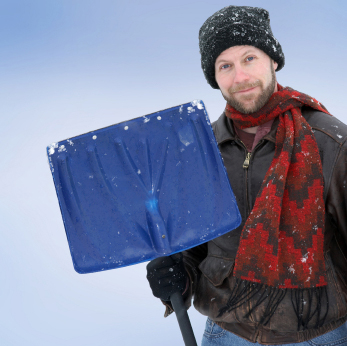Use Less Salt
At home, frequent shoveling is best!

Road salt is an important tool for making roads, parking lots, driveways and sidewalks safer during ice and snowstorms. But as the snow melts and becomes runoff, this salty water washes into our lakes, rivers and streams. It has an especially quick and easy path to our waterbodies through curbside storm drains, which don’t filter or treat runoff.
Increased levels of chloride from road salt and other de-icers in our freshwater systems is harmful or toxic to aquatic organisms, damages or kills vegetation and makes drinking water unhealthy for people.
HRWC recommends shoveling early and often. Avoid using salt and other de-icers altogether!
Balance your need for safety, potential environmental impacts, costs and convenience when choosing the best snow removal option for your home.
If you MUST use a de-icer, follow these tips:
- Consider a product that is labeled “environmentally or eco-friendly,” keeping in mind that most contain some chloride. Shop early in the season for more choices in the store.
- Check and follow the label’s application instructions for the most effective treatment. Some work better when applied before a snowfall to prevent ice from forming. Some stop working at colder temperatures. Pay attention to whether directions refer to air or pavement temperatures.
- Use as little as is needed to get the job done. More de-icer does not mean more melting. (When using salt, use less than 4 pounds per 1,000 square feet. One pound of salt is approximately a heaping 12-ounce coffee mug.)
- Limit your use of sand. Instead of melting ice, sand provides traction. But it also increases the amount of sediment in our lakes, rivers and streams.
- Promptly remove slush and any residual de-icers or sand from concrete surfaces to minimize polluted runoff. If de-icer or sand is visible on dry pavement it is no longer doing any work and will be washed away. Sweep it up and save it for later or throw it away.
Additional Resources:
“Improved Winter Maintenance: Good Choices for Clean Water,” a 15-minute video produced by the Mississippi Watershed Management Organization in 2011. Learn the best tools for keeping driveways and sidewalks safe this winter, what deicers work under different winter conditions and whether to use them at all, and the impacts of sand and deicers to our lakes, streams and groundwater.
Road salt, a stealthy pollutant, is damaging Michigan waters, Bridge Michigan, January 26, 2023
Michigan’s lakes, waterways are getting saltier. One spot tastes like brine, The Detroit News, March 27, 2022 (Subscriber Exclusive)
Road salt threatens Michigan lakes and rivers. Can an alternative take hold? Bridge Michigan, January 3, 2022
North America’s freshwater lakes are getting saltier, Science Daily, April 10, 2017
This Week in EPA Science, The EPA Blog, January 22, 2016
Road Salt is Polluting our Rivers, Wired, March 12, 2015
The Surprising History of Road Salt, National Geographic, February 14, 2014
What Happens to All the Salt We Dump On the Roads, Smithsonian.com, January 6, 2014
More technical information:
Freshwater salinization syndrome on a continental scale, Proceedings of the National Academy of Sciences, November 13, 2017
Salting our freshwater lakes, Proceedings of the National Academy of Sciences, March 8, 2017 (a study investigating long-term chloride trends in 371 freshwater lakes in North America)
The Effect of Road Salt on Urban Watersheds and Management Options, April 17, 2015 (a research paper on road salt application and subsequent implications on water quality, including data from the Huron River by Stevi Kosloskey, former HRWC Watershed Planning Assistant)
Solving Slick Roads and Salty Streams, Stormwater Report, March 4, 2015
Canada Sets National Targets for Road Salt, Study Shows Stream Toxicity from De-icers Increasing Rapidly, Stormwater Report, February 3, 2015
Pave and Seal Wisely
Porous pavement is the best option for the watershed.
If you can’t go porous, try to use concrete instead of asphalt.
Although concrete is more expensive, it will require less maintenance in the future.
Paved surfaces have a big impact on our streams and rivers because rainwater and pollutants wash off of them instead of being absorbed into the ground.
If you already have asphalt on your property, consider eliminating sealcoating as a maintenance practice for asphalt surfaces. If sealcoating cannot be eliminated, use an asphalt-based sealcoat rather than a coal tar sealcoat. There are contractors who will apply asphalt-based sealcoat, and this alternative is also available at most hardware stores. (Most major hardware store chains have already removed coal tar sealcoat from their shelves.)
For more information about coal tar, go here.
Wash your Car Responsibly
Use a commercial car wash
When you wash your car on a paved driveway, all of the soap, oil and dirt make their way directly into stormdrains and pollute streams and rivers. The most river-friendly way to wash your car is to use commercial car washes, which are required to direct their water into municipal sewers. That means the waste water gets treated to remove pollutants before being released back into the river. To be extra river-friendly, choose a car wash that recycles its wastewater.
If you do wash your car yourself, please wash it on the lawn where it will soak up the water, break down the soap, and keep dirty water out of the stormdrain. And when you’re done with automotive fluids, make sure to dispose of them properly, too



